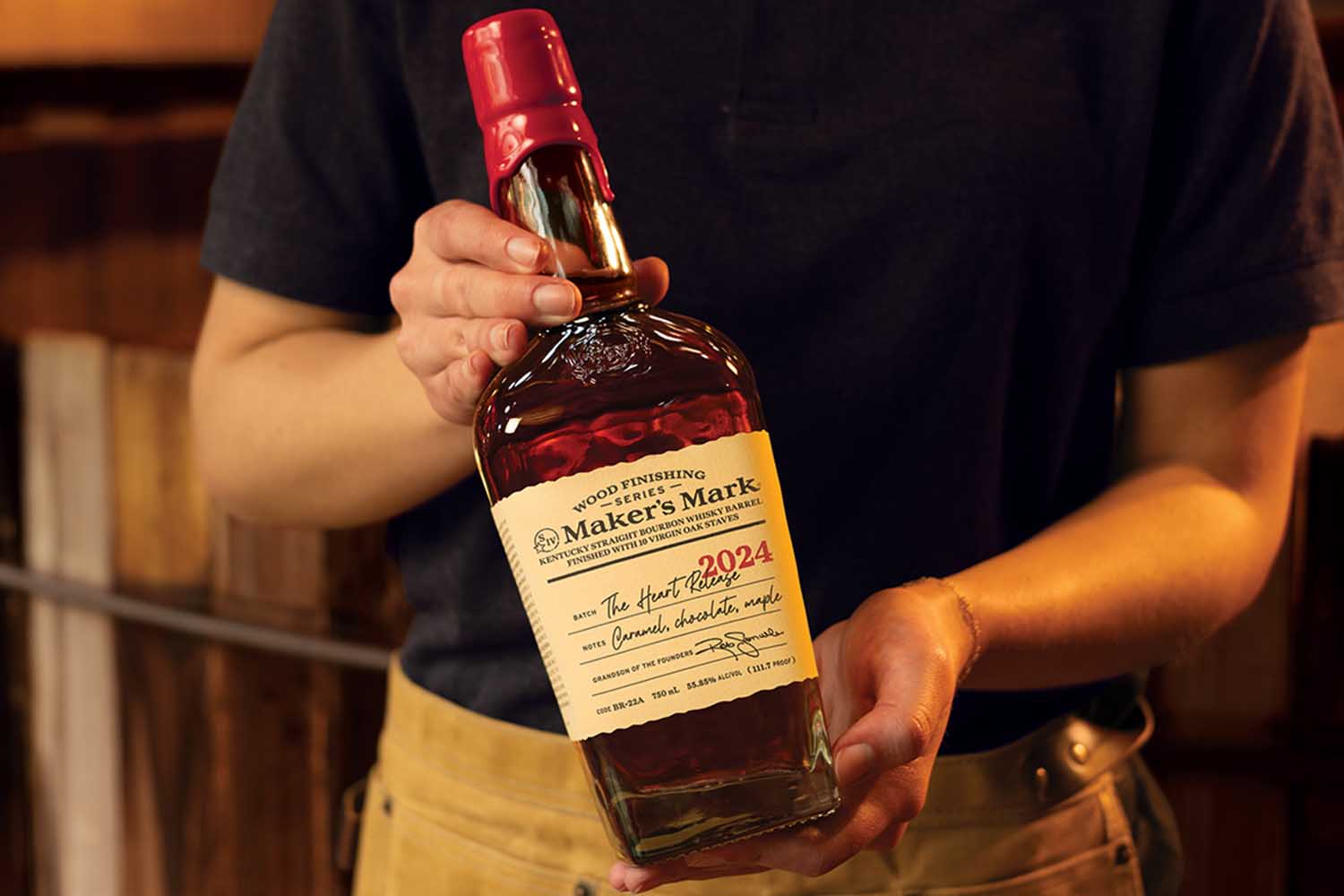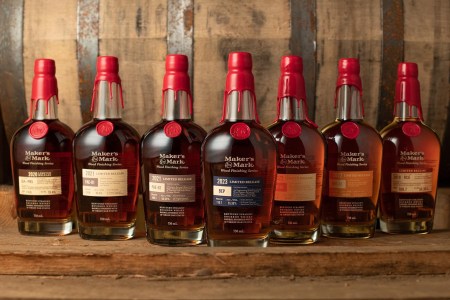Why Maker’s Mark brought back its wood finishing line

The Wood Finishing series made a surprise return this year, and the first release is outstanding

The Heart Release is a continuation of the Maker’s Mark Wood Finishing series.
Maker’s Mark uses the same mash in all of its variants, so when the distillery’s innovation lab wants to develop something new, it turns to wood—more specifically, wooden staves that impart or enhance flavors. This process is part of the distillery’s excellent Wood Finishing Series, which made a surprise return this year after seemingly being discontinued in 2023.
“We create the Wood Finishing Series to showcase the elements and complexity of our Cask Strength bottling,” explains J. Blake Layfield, Senior Director and Head of Innovation, Blending and Quality at Maker’s Mark. “The wood finishing allows us to bring out the flavors more clearly.”
We visited the Maker’s Campus in late spring to get a first taste of the revamped series. Leading the way was Layfield and fellow countrywoman Beth Buckner (Senior Manager, Innovation and Blending), who introduced us to the 2024 WFS version, “The Heart Release.” It’s quite different from the Loretto, KY distillery’s previous wood-treated bottles. First of all, it has an easy-to-remember name.
“We launched this series in 2019 with RC6, and the bottles were meant to tell stories that were specific to our whisky-making process; RC6 was about our yeast and the flavors that could come out of it,” says Layfield. A series of similar releases followed with names like BEP, FAE-02 and BRT-01. After that, “our CEO told us there should be no more R2-D2 names,” Layfield adds with a laugh.

The biggest change, however, has been the inspiration behind the bottles, which vary greatly in flavor and profile but are typically some of our favorite bourbons of the year. While previous WFS releases have focused on the whiskey-making processes, such as yeast selection, barrel location, or barrel entry strength, the new Heart release is about people—more specifically, the people who work at Maker’s distillery.
“Instead of Blake and I sitting around and saying ‘we want the whiskey to taste like this,’ we took a completely different approach,” says Buckner. “We met with all 21 members of our distillery team and asked, ‘Tell me what you taste and feel and smell as you work.’ And we kept hearing caramelized and caramel. And then maple and chocolate kept coming up, but it was very specific steps in the processes that resonated with these people. So we developed the flavor vision and settled on caramel, maple and chocolate as the notes we wanted to express.”
The lab team accomplished their goal with flying colors. Comparing the Heart Release to a regular cask strength Maker’s Mark (which, come to think of it, offers quite a s’mores note that I never noticed before), you’ll find that those very maple, chocolate, and caramel flavors are amplified. The key to achieving this goal is two types of French oak staves cooked at different times and temperatures—one had the cask strength base aged with those staves in Maker’s limestone cellar for an additional five weeks, the other for nine weeks before both batches were blended together.

Maker’s Mark probably has the most lavish and beautiful property of all the distilleries we visited.
Kirk Miller
The good news is that this limited edition is just the beginning of a new five-year series. Each year, a different wood-finished bottle will be released, reflecting the “unique stories of each of our respective teams on campus,” Buckner notes.
It’s an innovative method of converting whiskeys, all made from the same mash of 70% corn, 16% wheat, and 14% malted barley. But innovation has been a key part of Maker’s history. Founded in 1953 by Bill Samuels Sr. (who, like most American brown spirits makers, calls itself “whisky” rather than “whiskey”), the distillery used soft red winter wheat as a unique grain for flavoring. The company also became known for hand-turning each of its barrels. Samuels’ wife, Margie, is the one who came up with the bourbon’s name, label, bottle shape, and signature hand-dipped red wax coating.
More recently, Maker’s has added several new bottlings to its portfolio, including Maker’s Mark 46, Maker’s Mark Cask Strength and last year’s impressive Maker’s Mark Cellar-Aged, which spent the second half of its 11-year aging in a climate-controlled limestone cellar. Maker’s also recently became one of the few B-Corp certified distilleries and is considered a pioneer in regenerative agriculture.

In the Innovation Lab, some old and new Maker’s Mark will be presented; the taste vision for the brand
Kirk Miller
Overall, it’s a rather unusual story for a bourbon brand, as can be seen on a board in the distillery’s innovation lab that outlines the vision Samuels (and his son Bill Jr.) laid out for Maker’s years ago. Their notes ranged from fairly broad specifications for the core product (“rich in flavor, but smooth and delicate, distinct and complex”) to simpler and more direct instructions for Maker’s Mark 46, the distillery’s first innovation (my favorite Bill Jr. instructions: “tasty” and “MM on steroids”).
“Innovation doesn’t just mean it’s new, fun and exciting – it means focusing on the core product,” says Buckner. “Blake talks about being protectors of the liquid. That’s what we do every day. We start with Bill Senior’s vision of taste. Bill was very unrealistic – that’s how he wanted you to feel when you drank whiskey. It was the color of warmth. It’s comfortable and inviting. It should leave you feeling warm and be a complete pleasure. And so we still protect the ethos of what he wanted to achieve with this brand every day.”

Maker’s Mark Wood Finishing Series: The Heart Version
Subscribe to America’s Fastest Growing Spirits Newsletter The spill. Unlock all reviews, recipes and festivities — And Get 15% off the award-winning Mezcal La Tierra de Acre.



